
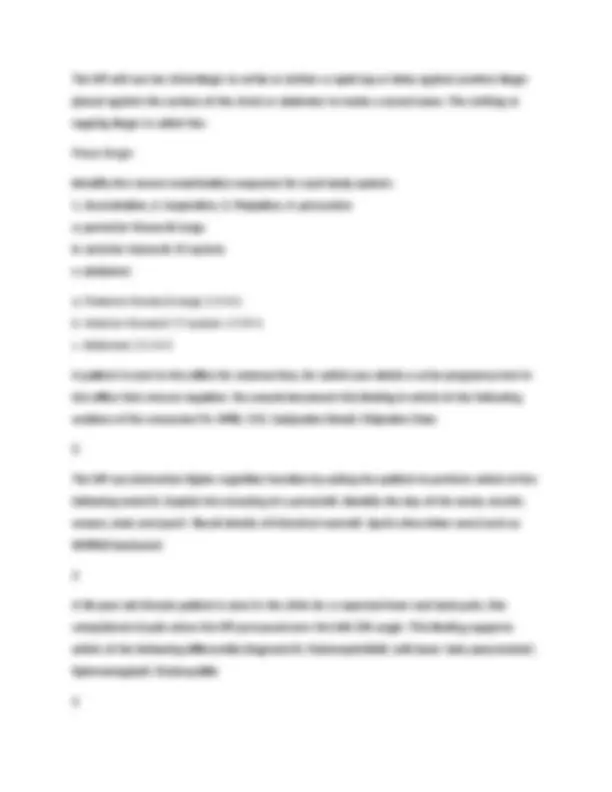
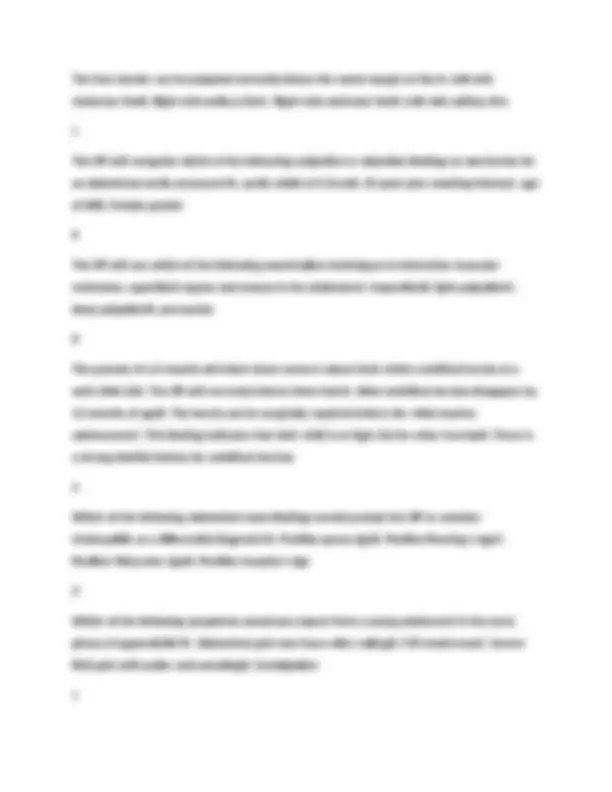

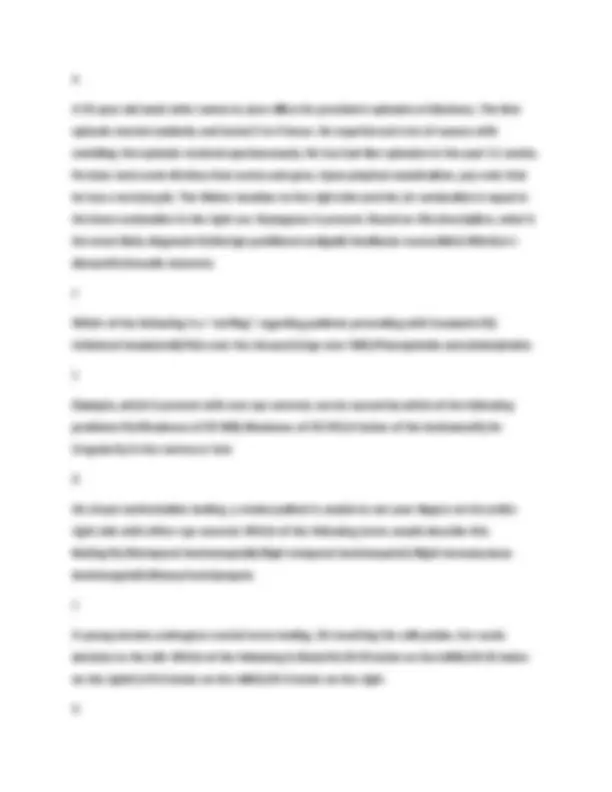
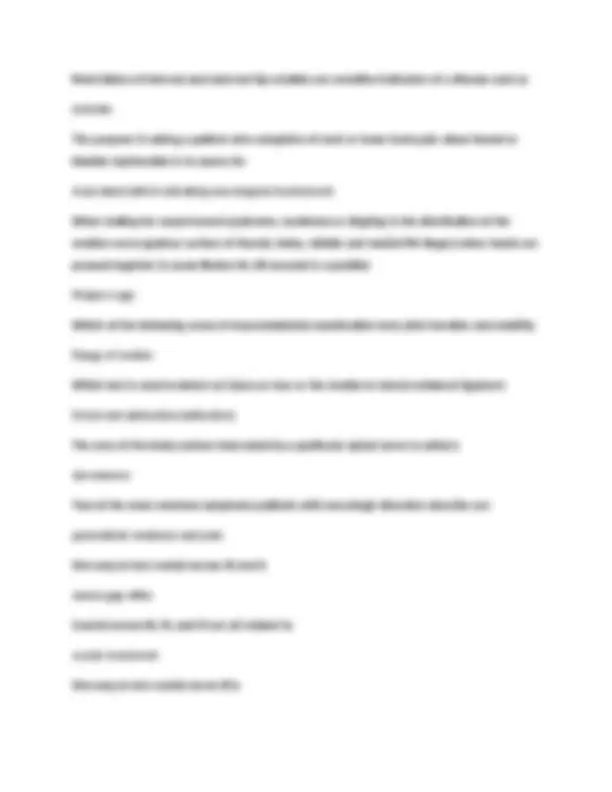
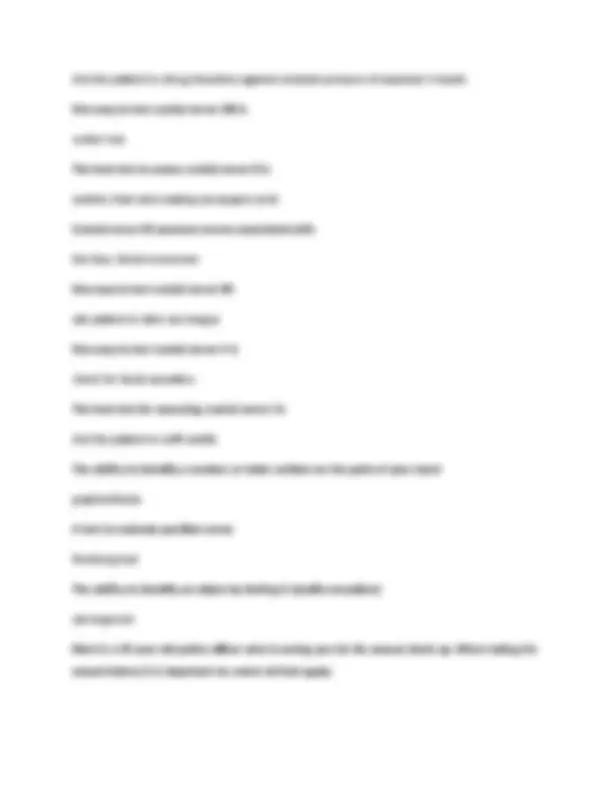
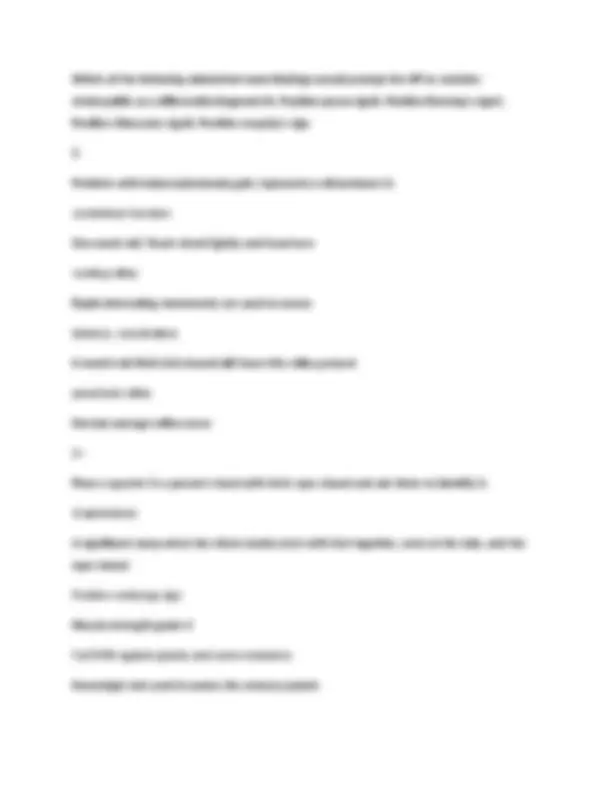
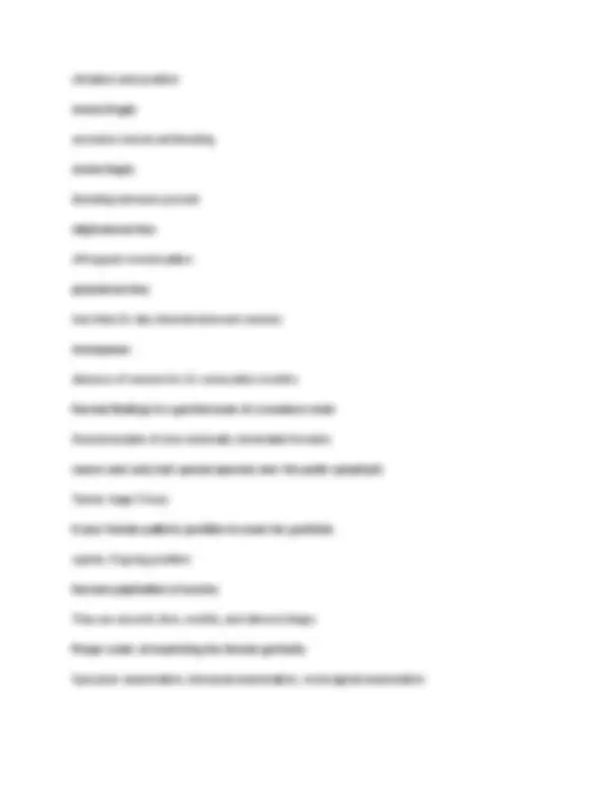
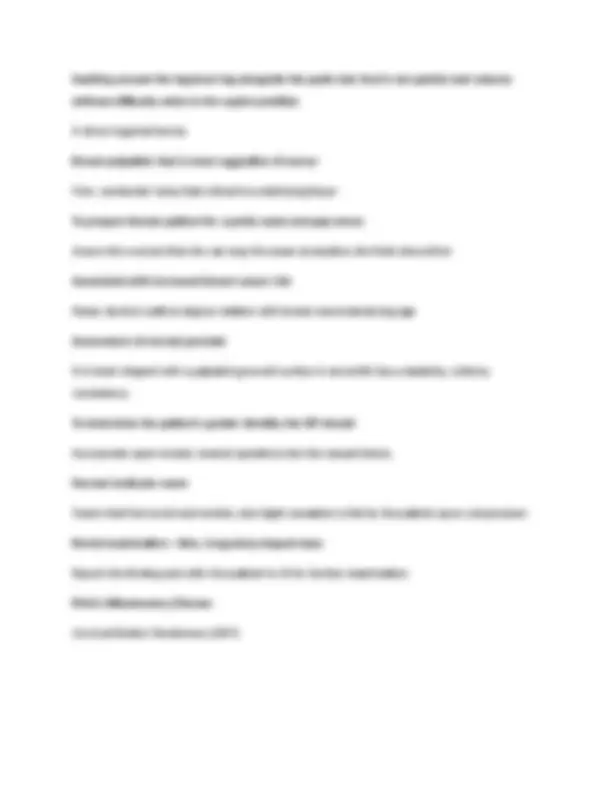


Study with the several resources on Docsity

Earn points by helping other students or get them with a premium plan


Prepare for your exams
Study with the several resources on Docsity

Earn points to download
Earn points by helping other students or get them with a premium plan
Community
Ask the community for help and clear up your study doubts
Discover the best universities in your country according to Docsity users
Free resources
Download our free guides on studying techniques, anxiety management strategies, and thesis advice from Docsity tutors
2025 ADVANCED HEALTH ASSESSMENT EXAM 1 QUESTIONS AND 100% CORRECLTY VERIFIED ANSWERS GRADED 2025 ADVANCED HEALTH ASSESSMENT EXAM 1 QUESTIONS AND 100% CORRECLTY VERIFIED ANSWERS GRADED 2025 ADVANCED HEALTH ASSESSMENT EXAM 1 QUESTIONS AND 100% CORRECLTY VERIFIED ANSWERS GRADED 2025 ADVANCED HEALTH ASSESSMENT EXAM 1 QUESTIONS AND 100% CORRECLTY VERIFIED ANSWERS GRADED 2025 ADVANCED HEALTH ASSESSMENT EXAM 1 QUESTIONS AND 100% CORRECLTY VERIFIED ANSWERS GRADED 2025 ADVANCED HEALTH ASSESSMENT EXAM 1 QUESTIONS AND 100% CORRECLTY VERIFIED ANSWERS GRADED 2025 ADVANCED HEALTH ASSESSMENT EXAM 1 QUESTIONS AND 100% CORRECLTY VERIFIED ANSWERS GRADED 2025 ADVANCED HEALTH ASSESSMENT EXAM 1 QUESTIONS AND 100% CORRECLTY VERIFIED ANSWERS GRADED
Typology: Exams
1 / 15

This page cannot be seen from the preview
Don't miss anything!










When percussing the abdomen in a patient with constipation, which of the following sounds would you expect to find in the LLQ? A. Tympanic B. Dull C. Resonant D. Hyperresonant B Which of the following represents the proper position for the NP to assess the patient's abdomen? A. Stand at the patient's left side and proceed in a systematic fashion. B. Stand at the patient's left side and assess any problem areas first C. Stand at the patient's right side and process in a systemic fashion D. Stand at the patient's right side and assess any problem areas first C The NP will demonstrate the correct order of examination for the abdomen by using examination techniques that follows:
The NP will use which of the following examination techniques to determine muscular resistance, superficial organs and masses in the abdomen A. inspection B. light palpation C. deep palpation D. percussion B The NP will use which of the following methods to help the patient relax during the abdominal exam? A. ask the patient to hold their breath B. Palpate the abdomen after inspiration C. palpate the abdomen after expiration D. Palpate the abdomen using quick short movements C When percussing the abdomen, you would document the normal finding of percussion over the intestines as: A. Tympanic B. Dull C. Resonant D. Hyperresonant A
The liver border can be palpated normally below the costal margin at the:A. Left mid- clavicular lineB. Right mid-axillary lineC. Right mid-calvicular lineD. Left mid-axillary line C The NP will recognize which of the following subjective or objective findings as worrisome for an abdominal aortic aneurysm?A. aortic width of 2.8 cmB. 25 pack-year smoking historyC. age of 60D. Female gender B The NP will use which of the following examination techniques to determine muscular resistance, superficial organs and masses in the abdomenA. inspectionB. light palpationC. deep palpationD. percussion B The parents of a 4-month-old infant share concern about their child's umbilical hernia at a well-child visit. The NP will correctly inform them that:A. Most umbilical hernias disappear by 12 months of ageB. The hernia can be surgically repaired before the child reaches adolescenceC. This finding indicates that their child is at high risk for other herniasD. There is a strong familial history for umbilical hernias A Which of the following abdominal exam findings would prompt the NP to consider cholecystitis as a differential diagnosis?A. Positive psoas signB. Positive Rovsing's signC. Positive Obturator signD. Positive murphy's sign D Which of the following symptoms would you expect from a young adolescent in the early phase of appendicitis?A. Abdominal pain two hours after eatingB. CVA tendernessC. Severe RLQ pain with pallor and sweatingD. Constipation C
A 57-year-old maintenance worker comes to your office for evaluation of pain in his legs. He has smoked two packs per day since the age of 16, but he is otherwise healthy. You are concerned that he may have peripheral vascular disease. Which of the following is part of common or concerning symptoms for the peripheral vascular system?A) Intermittent claudicationB) Chest pressure with exertionC) Shortness of breathD) Knee pain A Which area of the arm drains to the epitrochlear nodes?A) Ulnar surface of the forearm and hand, little and ring fingers, and ulnar middle fingerB) Radial surface of the forearm and hand, thumb and index fingers, and radial middle fingerC) Ulnar surface of the forearm and hand; second, third, and fourth fingersD) Radial surface of the forearm and hand; second, third, and fourth fingers A Mr. E complains of cramps and difficulties with walking. The cramps occur in his calves consistently after walking about 100 yards. After a period of rest, he can start to walk again, but after 100 yards these same symptoms recur. Which of the following would suggest spinal stenosis as a cause of this pain?A) Coldness and pallor of the legsB) Relief of the pain with bending at the waistC) Color changes of the skinD) Swelling with tenderness of the skin B Which of the following pairs of ischemic symptoms versus vascular supply is correct?A) Lower calf/superficial femoralB) Erectile dysfunction/iliac or pudendalC) Buttock/common femoralD) Upper calf/tibial or peroneal B A patient demonstrates left facial droop but can wrinkle both sides of the forehead. The examiner should suspect a problem with:(A) Central innervation of cranial nerve VII (facial)(B) Cranial nerve V (trigeminal)(C) Peripheral innervation of cranial nerve VII(D) Frontalis muscle A
Which of the following percussion notes would you obtain over the gastric bubble?A) ResonanceB) TympanyC) HyperresonanceD) Flatness B A 38-year-old accountant comes to your clinic for evaluation of a headache. The throbbing sensation is located in the right temporal region and is an 8 on a scale of 1 to 10. It started a few hours ago, and she has noted nausea with sensitivity to light; she has had headaches like this in the past, < 1/wk, but not as severe. She does not know of any inciting factors. There has been no change in the frequency of her headaches. She usually takes an over-the counter analgesic and this results in resolution of the headache. Based on this description, what is the most likely diagnosis of the type of headache?A) TensionB) MigraineC) ClusterD) Analgesic rebound B A 29-year-old computer programmer comes to your office for evaluation of a headache. The tightening sensation is located all over the head and is of moderate intensity. It used to last minutes, but this time it has lasted for 5 days. He denies photophobia and nausea. He spends several hours each day at a computer monitor/keyboard. He has tried over-the-counter medication; it has dulled the pain but not taken it away. Based on this description, what is your most likely diagnosis?A) TensionB) MigraineC) ClusterD) Analgesic rebound A A 49-year-old administrative assistant comes to your office for eval of dizziness. You elicit the information that the dizziness is a spinning sensation of sudden onset, worse with head position changes. The episodes last a few seconds and then go away, and they are accompanied by intense nausea. Vomiting x1. She denies tinnitus. You perform a physical exam of the head and neck and note that the patient's hearing is intact to Weber and Rinne and that there is nystagmus. Her gait is normal. Based on this description, what is the most likely diagnosis?A) Benign positional vertigoB) Vestibular neuronitisC) Ménière's diseaseD) Acoustic neuroma
A 55-year-old bank teller comes to your office for persistent episodes of dizziness. The first episode started suddenly and lasted 3 to 4 hours. He experienced a lot of nausea with vomiting; the episode resolved spontaneously. He has had five episodes in the past 1½ weeks. He does note some tinnitus that comes and goes. Upon physical examination, you note that he has a normal gait. The Weber localizes to the right side and the air conduction is equal to the bone conduction in the right ear. Nystagmus is present. Based on this description, what is the most likely diagnosis?A) Benign positional vertigoB) Vestibular neuronitisC) Ménière's diseaseD) Acoustic neuroma C Which of the following is a "red flag" regarding patients presenting with headache?A) Unilateral headacheB) Pain over the sinusesC) Age over 50D) Phonophobia and photophobia C Diplopia, which is present with one eye covered, can be caused by which of the following problems?A) Weakness of CN IIIB) Weakness of CN IVC) A lesion of the brainstemD) An irregularity in the cornea or lens D On visual confrontation testing, a stroke patient is unable to see your fingers on his entire right side with either eye covered. Which of the following terms would describe this finding?A) Bitemporal hemianopsiaB) Right temporal hemianopsiaC) Right homonymous hemianopsiaD) Binasal hemianopsia C A young woman undergoes cranial nerve testing. On touching the soft palate, her uvula deviates to the left. Which of the following is likely?A) CN IX lesion on the leftB) CN IX lesion on the rightC) CN X lesion on the leftD) CN X lesion on the right D
Ask the patient to shrug shoulders against resistant pressure of examiner's hands One way to test cranial nerve VIII is weber test The best test to assess cranial nerve II is snellen chart and reading newspaper print Cranial nerve VII assesses nerves associated with the face, facial movement One way to test cranial nerve XII ask patient to stick out tongue One way to test cranial nerve V is check for facial sensation The best test for assessing cranial nerve I is Ask the patient to sniff vanilla The ability to identify a number or letter written on the palm of your hand graphesthesia A test to evaluate position sense Romberg test The ability to identify an object by feeling it (tactile sensation) stereognosis Mark is a 35 year old police officer who is seeing you for his annual check up. When taking his sexual history it is important to: select all that apply.
Which of the following abdominal exam findings would prompt the NP to consider cholecystitis as a differential diagnosis?A. Positive psoas signB. Positive Rovsing's signC. Positive Obturator signD. Positive murphy's sign D Problem with balance/unsteady gait; represents a disturbance in cerebellum function One week old: Touch cheek lightly and head turn rooting reflex Rapid alternating movements are used to assess balance, coordination 6 month old Well visit should still have this reflex present parachute reflex Normal average reflex score 2+ Place a quarter in a person's hand with their eyes closed and ask them to identify it. Graphestesia A significant sway when the client stands erect with feet together, arms at the side, and the eyes closed Positive rombergs sign Muscle strength grade 4 Full ROM against gravity and some resistance Neurologic test used to assess the sensory system
vibration and position menorrhagia excessive menstrual bleeding metorrhagia bleeding between periods oligiomenorrhea infrequent menstruation polymenorrhea less than 21-day intervals between menses menopause absence of menses for 12 consecutive months Normal findings in a genital exam of a newborn male Nonretractable of only minimally retractable foreskin coarse and curly hair spread sparsely over the pubic symphysis Tanner stage 3 boys 6 - year female patient; position to exam her genitalia supine, frog-leg position Normal palpitation of ovaries They are smooth, firm, mobile, and almond shape Proper order of examining the female genitalia Speculum examination, bimanual examination, rectovaginal examination